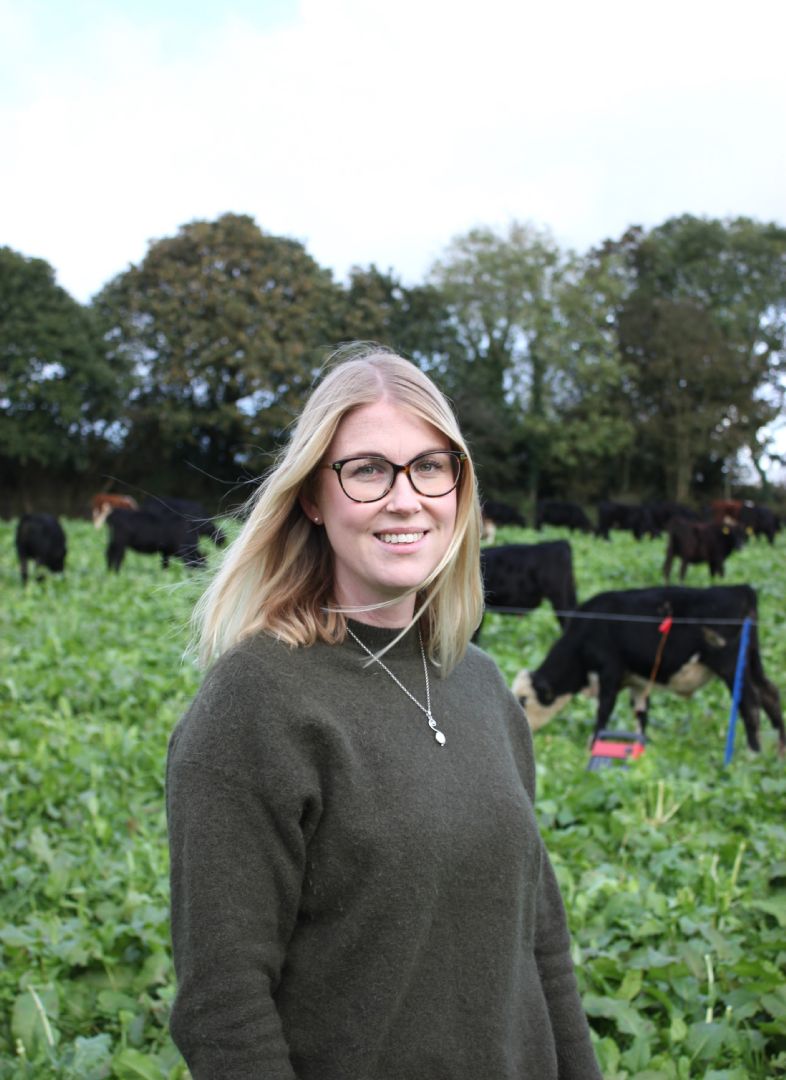
Farm resilience is the capacity of a farm system to anticipate, reduce, absorb, adapt to and recover from challenges such as climate change, economic shifts, policy change and environmental stresses, to ensure sustained productivity, profitability and sustainability over a long period of time.
In a recent webinar, which took place during Countryside COP week 2024, Innovation for Agriculture brought together four farmers who are taking a proactive approach to adapting to climate change and mitigating the impact of their farming systems on climate.
In the webinar, Laura Awdry shared how in the two years since moving to a new farm in Cornwall, she and her husband Sam have focused on building soil organic matter (SOM) by using herbal leys and grazing livestock as a tool to accelerate the biological recovery of their soil, which had come out of intensive vegetable production.
Setting up a new farm system
Laura Awdry and her husband Sam took on a 20-year farm business tenancy and moved to their 334-acre farm in 2022. They are predominantly beef producers, with their main enterprise being a calf rearing enterprise, taking 600 Angus cross dairy calves from local dairy farms each year. These are reared in two blocks, with 300 arriving on-farm in the spring and another 300 arriving in autumn. There are also approximately 150 growing cattle grazing on the farm at any time, plus a 38-cow suckler herd.
When they arrived at the new farm in September 2022, 169 acres were bare soil from arable, vegetable and potato production, with only about 100 acres of grassland. They knew from the start that soil health was going to be a priority – to support grass production, carbon sequestration and water infiltration – so immediately set about establishing cover crops and grass leys to get the soil covered and avoid run-off. They also had SOM measured in every field, which showed big differences between the permanent pasture and the fields that had been used for arable and vegetable production. This has provided a baseline so going forwards Laura and Sam will be able to measure how their farming system is influencing SOM.
Grazing herbal leys and multi-species swards for improved profitability
Looking at a traditional grass growth curve in the UK, there is always a dip in the summer. Laura and Sam knew they were going to be a pasture-based system and did not want to have to be reliant on artificial fertiliser, so needed to ensure a continuous supply of grass growth.
Since Laura and Sam arrived, they have put in 126 acres of herbal leys and multi species swards. These are an important part of the production system, as plants with deeper rooting depths bring minerals up, making them accessible to the cattle grazing and subsequently recycled into the top layers of soil through manure. They have found with herbal leys that there is not a sharp peak in May, but a steady curve which avoids the dips in July. The mix of species creates a strong biomass, which provides a balanced diet for the livestock over the grazing season.
Laura shares that herbal leys or multi-species swards are used for all youngstock once they are weaned, with autumn-born cattle being finished on herbal leys as well. They have used a lot of semi-permanent electric fencing and portable water troughs to cell-graze ex-arable fields. Grazing cattle are used as a vital tool, enabling reduced reliance on artificial inputs and less fuel consumption as frequency of tractor work is reduced, which has cost saving benefits for the farm business.
Furthermore, the herbal leys have high crude protein and energy levels, which has profitability benefits as livestock can be finished without using any concentrate feeds after seven months of age. There is also no need for routine worming of livestock, because they are being moved frequently.
Rejuvenating pasture
Keen to reduce reliance on fossil fuels and minimise soil structure, Laura and Sam have been experimenting with ways of rejuvenating pasture without ploughing and reseeding. They have tried some overseeding by using cattle to graze the sward down, drilled over the top of it using disc drill then putting the cattle back on it to reduce competition from already established plants.
Being big fans of working with what you already have on-farm, Laura and Sam have also experimented with improving the permanent pasture grassland, which is already providing an incredible level of SOM and acting as a carbon sink. They are doing this with high impact rotational grazing, with long recovery to encourage regeneration. They are not using any fertiliser on the permanent grassland and have used species rich bale grazing to incorporate more seeds.
Improving animal performance
Laura and Sam are finding they have some really good grassland and SOM in the soil already, which they can use to their advantage to optimise animal performance. They are aiming to have their suckler cows calving at 24 months and for finishing cattle to be ready and off the farm before 24 months, to reduce methane produced per kg beef.
Managing the grasslands and making sure the right cattle are in the right place is integral to this. The sucklers are grazed on the more native pastures, as they are able to perform well on this in terms of converting the forage and growing the calf. The finishing and calf rearing enterprises are focused on the lowland ground, where the grazing of herbal leys and multi-species swards can be more intensive.
In summary, Laura and Sam use cover cropping, forage cropping and herbal leys, in conjunction with grazing livestock, to improve the soil structure on the farm. They are focused on building SOM, improving water infiltration rates, developing a healthy ecosystem and providing a diet which enables high performance for all livestock on the farm. To hear more from Laura about how she and her husband have focused on soil health while establishing their farm system, watch the original webinar here.




